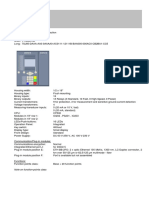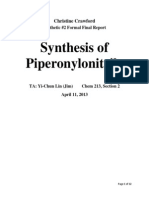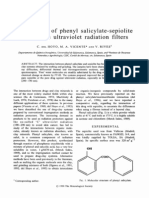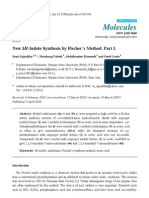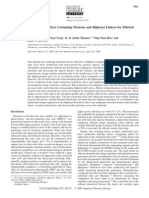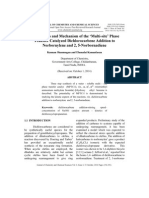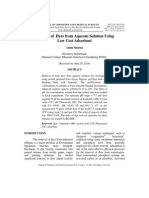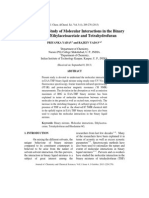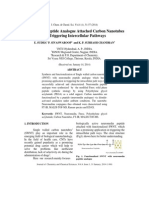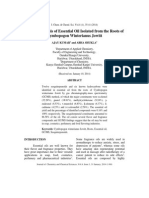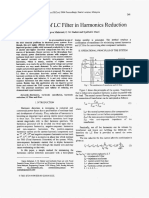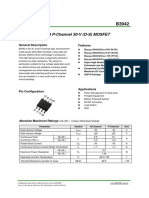Synthesis and Characterization of Polyaniline Based Conducting Polymers
Synthesis and Characterization of Polyaniline Based Conducting Polymers
Uploaded by
chemistryjournalCopyright:
Available Formats
Synthesis and Characterization of Polyaniline Based Conducting Polymers
Synthesis and Characterization of Polyaniline Based Conducting Polymers
Uploaded by
chemistryjournalOriginal Title
Copyright
Available Formats
Share this document
Did you find this document useful?
Is this content inappropriate?
Copyright:
Available Formats
Synthesis and Characterization of Polyaniline Based Conducting Polymers
Synthesis and Characterization of Polyaniline Based Conducting Polymers
Uploaded by
chemistryjournalCopyright:
Available Formats
JOURNAL OF CHEMISTRY AND CHEMICAL SCIENCES
An International Open Free Access, Peer Reviewed Research Journal
www.chemistry-journal.org
ISSN
ISSN 2229-760X
0976-5727 (Print)
ISSN 2319-7625
2319-8133 (Online)
Abbr:
Abbr:J.Comp.&Math.Sci.
J. Chem. & Cheml. Sci.
2014,
Vol.5(1):
Pg.1- 4
2014,
Vol.4
(2): Pg.90-97
Synthesis and Characterization of Polyaniline Based
Conducting Polymers
M. B. Wasu1 and A. R. Raut2
1
Research Student,
Government Vidarbha Institute of Science and Humanities,
Amaravati, M. S., INDIA.
2
Reader,
Government Vidarbha Institute of Science and Humanities,
Amaravati, M. S., INDIA.
(Received on: April 4, 2014)
ABSTRACT
Present work deals with the synthesis of Polyaniline, polynitro
aniline, poly m-toludine and poly o-toludine polymers by
chemical oxidation method using ammonium per sulfate as
chemical oxidant. The yield of all polymers was higher than
90%.The synthesized polymeric material have been characterized
by FTIR spectroscopy. FTIR and SEM studies of polymer show
the structural and slight morphological changes with change in
substituent in monomer units.
Keywords: Polyaniline, polynitro aniline, poly m-toludine, poly
o-toludine, ammonium per sulfate.
INTRODUCTION
The conducting polymers were
emerged as materials of current research
worldwide. The conducting polymers have
mechanical parameters of polymers as well
as electrical properties of semiconductors.
Among the various conducting polymers
polyaniline and its derivatives are
intensively studied, because of their good
environmental, chemical, thermal stability.1-6
These conducting polymers can be
synthesized chemically or electrochemically7,8. The special characteristics of
polyaniline is that it can be doped or
undoped by reacting with acidic or alkaline
environment without any change in number
of electrons.9 This can be possible because
of presence of NH and N groups in polymer
backbone. These groups on protonation or
Journal of Chemistry and Chemical Sciences Vol. 4, Issue 2, 30 April, 2014 Pages (70-117)
91
M. B. Wasu, et al., J. Chem. & Cheml. Sci. Vol.4 (2), 90-97 (2014)
deprotonation bring the changes in color
and electronic conductivity10 The amine or
imine nitrogen atom in any compound can
be protonated by protonic acids.11 This
doping and undoping property gives the Pani
and its analogous polymers
enormous
industrial applications12. Protonation or
doping of polyaniline by acids can be done
during polymerization of aniline in presence
of acids in polymerization solution13 or after
polymerization by adding polymer in acid
solution14. Type of acid and concentration of
acid affect the degree of polymerization of
of amine and imine sites in polymer15
Different forms of form has conductivity on
semiconductor level (of the order of
100Scm1), much more higher than common
polymers(<10-9Scm-1) but lower than typical
metals(>104Scm-1). Pani hydrochloride i.e.
protonated pani convert to non conducting
blue emeraldine polyaniline have different
physical and chemical properties.16,17 The
green protonated emeradine base when
treated with ammonium hydroxide.18-20 Pani
and pani based other conjugated polymers
have presence of unique plectrons, the
wave function of these electrons are
delocalized over a long portion of polymer
chain when molecular structure of the
backbone is planar.
EXPERIMENTAL
1.1 Synthesis of polyaniline
Aniline (Merck) was used after
distillation. Ammonium
per sulfate,
hydrochloric acid is of analytical grade. 25
ml freshly distilled aniline was added to 500
ml 2M Hydrochloric acid 250 ml of 0.25 M
APS (NH4)2S2O8 solution was added from a
burette into well stirred monomer solution
within 40 min. The polymerization was
carried out at room temp. The solution was
continuously stirred for 24 hours after
addition of oxidant. The green dark powder
obtained was washed with dil HCl, distilled
water and methanol. The synthesized
powder was treated with ammonia solution
(0.5) for four hour at room temp in order to
convert the polymer into emeraldine base
(EB).
1.2 Synthesis of poly m-toludine
10 ml m-toludine was mixed with
500ml 1M HCl, stirred for six hours 22g
Ammonium peroxy disulfate was dissolved
in 200ml 1M HCl. APS solution was
gradually mixed in meta toludine monomer
solution, blakish violet color was developed.
Stirring was continued for 24 hour with
magnetic stirrer. The blue ppt. obtained was
washed with distilled water and methanol.
The product obtained was dissolved in 0.5M
ammonia solution .The greenish blue
colored product was dried in oven at 600C
for 12 hours.
1.3 Synthesis of poly o-toludine
10 ml o-toludine was mixed with
500 ml 1M HCl. APS solution was gradually
mixed in, monomer solution. The reaction
mixture was stirred for 24 hours and then
filtered. The greenish violet ppt was washed
with distilled water and methanol and was
dissolved in 0.5 M ammonia solution for
four hour. The filtered product was dried in
oven at 60 0c for 12 hours.
1.4 Synthesis of polynitro aniline
Nitrating mixture was prepared by
mixing 10 ml H2SO4 and 4ml nitric acid,
Journal of Chemistry and Chemical Sciences Vol. 4, Issue 2, 30 April, 2014 Pages (70-117)
92
M. B. Wasu, et al., J. Chem. & Cheml. Sci. Vol.4 (2), 90-97 (2014)
mixture was cooled. To this nitrating
mixture, 3 g polyaniline was added, the
mixture was refluxed using air condenser at
40 0C for 2 hours. The product solution was
cooled and poured in 100 ml distilled water,
stirred and filtered. Product obtained was
washed with water methanol and the product
was dissolved in ammonia solution. The
filtered product was dried in oven at 60 0C
for 5 hour.
RESULTS AND DISCUSSION
FTIR spectra were obtained using
Spectrophotometer of Bruker make,
Germany Model (3000Hyperion Microscope
with vertex 80 FTIR System). Morphology
of synthesized polymers were studied by
Field Emission Gun Scanning Electron
microscopes (FEG SEM). Model-JSM7600F, Resolution 1.0nm (15kv.)
100
80
Transmittance
[%]
60
657.54
1040.73 861.94755.90
40
846.06738.79
3265.42
1238.11
1363.40
1623.08
20
726.69
1207.77
1297.89
1444.51
694.63
1173.16
1582.67
1413.97
1548.41
3500
3000
2500
2000
Wavenumber cm-1
1500
1000
500
Fig.1
100
877.27
941.16
90
514.96
692.29569.19
439.76
2918.21
810.42
3027.83
3182.82
1005.08
80
Transmittance
[%]
615.91
1037.91
70
1153.98
1230.48
1301.61
1402.06
1108.43
60
1595.29
1493.66
50
3500
3000
2500
2000
Wavenumber cm-1
1500
1000
Fig.2
Journal of Chemistry and Chemical Sciences Vol. 4, Issue 2, 30 April, 2014 Pages (70-117)
500
93
M. B. Wasu, et al., J. Chem. & Cheml. Sci. Vol.4 (2), 90-97 (2014)
100
2855.99
3022.22
2950.38
80
568.82
941.79
750.85
3355.33
Transmittance [%]
440.41
879.84
2917.33
1035.87
60
1004.16
40
810.76
1376.68
1155.33
1242.39
1305.60
20
1110.97
1596.43
1496.16
3500
3000
2500
2000
1500
1000
500
Wavenumber cm-1
Fig.3
100
99
753.71
1904.02 1707.42
814.97
519.26
428.22
615.25
98
2853.55
569.13
Transmittance
[%]
97
3420.8
2923.29
1382.45
1302.51
96
1212.08
1025.75
95
1156.48
1465.73
94
1597.19
1105.59
1495.51
93
3500
3000
2500
2000
Wavenumber cm-1
1500
1000
Fig.4
Journal of Chemistry and Chemical Sciences Vol. 4, Issue 2, 30 April, 2014 Pages (70-117)
500
M. B. Wasu, et al., J. Chem. & Cheml. Sci. Vol.4 (2), 90-97 (2014)
Fig.5,6
Fig.7,8
Journal of Chemistry and Chemical Sciences Vol. 4, Issue 2, 30 April, 2014 Pages (70-117)
94
95
M. B. Wasu, et al., J. Chem. & Cheml. Sci. Vol.4 (2), 90-97 (2014)
quinoid-benzenoid-quinoid
ring.
C-H
stretching vibrations in benzenoid ring
vibration mode. Peak at 1110 cm-1 is
assigned to methyl substituted benzenoid
and quinoid
ring. 940,879,750 cm-1
corresponds to C.
Fig.1 shows FTIR spectra of polyaniline.
As is shown from the fig. 3265 cm-1
corrospond to then N-H stretching mode of
secondary amine. 1600-1450cm-1this region
is aggigned for for N-H deformation,
Aromatic ring breathing, C=N stretching. 1,4
substituted benzene ring may give
absorption at 1600-1580 cm-1.The peaks at
1582 cm-1and 1548 cm-1 is assigned to the
benzenoid and quinoid form of PANI
backbone.19,201400-1200cm-1is C-N stretching region for aromatic amines. 1200-500
cm-1 is the region for in plane and out of
plane bending of C-H in aromatic ring.
Peak at 1302 cm-1 is assigned to C-N
oscillations in benzene ring. The peak at
1173 cm-1 corresponds to C-H in plane
oscillations.
Fig. 2 shows the FTIR spectra of mtoludine. The broad band observed in spectra
at 3182 cm-1 is assigned to N-H stretching
mode. The characteristic band at 2918 cm-1
show Vibrations of CH3 group. The peak at
1595 cm-1 and 1493 cm-1are assigned to the
stretching vibrations of benzenoid and
quinoid ring. The peak appearing at 1402
cm-1 indicates the symmetric deformation of
-CH3 group. 1301 cm-1 and 1230 cm1
.crroesponds to the C-N vibration. The peak
at 1153 cm-1 is assigned to C-H stretching of
benzenoid ring. The 1108 cm-1peak is
assigned to C-C stretching vibrations of
methyl substituted benzenoid and quinoid
structure. The prominent peaks at
941,877,810 cm--1assigned to an out of plane
C-H vibrations and 1,2,4 substituted
benzenoid ring and in plane C-H vibrations
quinoid ring. The peak at 692 cm-1.C-H
bending and 615 cmi-1 indicate aromatic ring
deformation. The peaks at 569, 514 and 439
cm-1 corroresponds C-C stretching in
benzenoid ring, C-C stretching and C-N
stretching in benzenoid and qui noid
structures respectively.
Fig.3 shows the FTIR spectra of poly otoludine.3355cm-1 is assigned to N-H
stretching. Peak
at 2917,2855 cm-1
corresponds to the C-H stretching due to
substituted methyl group.1596 cm-1 peak
indicate C-N stretching
of quinoid
structure.1376 cm-1 peak is assigned to
C=N+ stretching vibrations18. 1305 and 1242
cm-1 peaks corresponds to C-N vibrations in
alternate units of H out of plane vibrations.
C-C stretching vibrations of benzenoid ring
are indicated by peak at 568cm-1 21. 440cm-1
peak is assigned to C-N stretching in
benzenoid and quinoid ring.
Fig.4 shows the FTIR spectra of Polynitro
aniline Peak at 3420cm-1 indicate N-H
stretching. The characteristic peaks at 1597,
1495 cm-1 corresponds to asymmetric and
symmetric stretching vibrations in NO2
group. The absorption band at 1302 cm-1
indicate C-N vibrations in alternate units of
semiquinoid and quinoid ring.1212- 428 cm1
is the region of in plane and out of plane CH bending in aromatic ring.753 cm-1
corresponds to in plane bending of C-NO2.
615cm-1 peak is assigned to aromatic ring
deformation.
Fig.5,6,7,8 shows the SEM images of
Polyaniline, poly m-toludine, poly otoludine, poly nitroaniline respectively.
Journal of Chemistry and Chemical Sciences Vol. 4, Issue 2, 30 April, 2014 Pages (70-117)
M. B. Wasu, et al., J. Chem. & Cheml. Sci. Vol.4 (2), 90-97 (2014)
Characterization of synthesized
polymers was also carried out using
scanning electron microscopy (SEM). All
electron micrographs were obtained from the
powdered form of polymers. SEM
micrograph of polymers in base form gives a
smooth and homogeneous appearance. SEM
images
shows
the
differences
in
morphologies of the polymers.
CONCLUSION
PANI based polymers have been
successfully synthesized by using chemical
oxidation method.SEM images shows the
amorphous nature of polymers. FTIR spectra
obtained in the work are in agreement with
FTIR characterization reported in the
literature and comparison with standards23.
So FTIR spectra confirm the formation of
Polyaniline,
Poly m-toludine, Poly otoludine, polynitroaniline. Results shows
that Poly o-toludine and Poly m-toludine
N-H stretching bands become more broad
indicatingthe extensive h-bonding between
the polymeric strands.SEM studies shows
that smooth and homogeneous morphology
with slight differences due to nature and
position of group in monomer. Further
studies in progress is focused on the doping
of lanthanide metals in these synthesized
polymers and effect of doping on their
conductivity.
Acknowledgement- Authors are thankful to
the Chemical analysis lab, SAIF, IIT,
Bombay for extending FTIR and SEM
facilities.
REFERENCES
1. Z. Hau. J Shi L.Zhang, M. Rcan. Adv.
Matter, 14,830 (2002).
96
2. H. Naarman, Science and Application of
conducting polymer, Adam Hilger,
Briistal, (1991).
3. Trivedi, D.C. In Handbook of Organic
conductive molecules and Polymers,
Nalwa, H. S.Ed., Wiley, Chinchester,
England, Vol 2, p 505 (1993).
4. Pranon Jyoti Saikia, Pratap Chandra
Samarth,
Material
Science
and
Applications, 2,1022-1026 (2011).
5. Dasquali M. Pistoia G. Rosati R.,
Synthetic Metals, 53, 1-15 (1990).
6. Stejaslal, J. and R. G. Gilbart,
Polyaniline preparation of a conducting
polymer (IUPAC Technical report),
Pure Appl. Chem., 74.857-867 (2002).
7. M. Bammahd Keivani, K. Zare, M.
Aghaie , H. Aghaie, M. Monajjemi, E
journal of Chemistry,7(1), 105-110
(2010).
8. Angelopoulos M, Ravnd A, Macdiarmid
A G and Epstein A., Synthetic Metals,
21,21-30 (1987).
9. Chen S.A., Lin L.C. polyaniline doped
by new class of dopants, ionic salts,
structure and properties, Macromolecules, 28, 1239-1245 (1995).
10. Kous S. Chandra R Dhawan S.K., Sons
Actuators B, Chem,75,151-159 (2000).
11. MacDiarmid A.G. Epstein A.J., Farad,
Discuss, Chem. Soc.,88,317-332 (1989).
12. Abdolreza, Mirmohseni, Ali Ola
degaragoze, Farshad Fotoohifar, Iranian
Polymer Journal, 16(1),3-12 (2007).
13. Leyva M.E. Barra G.M.O., Soares B.G.,
Synth Net.,123,443-449 (2001).
14. Luthr V., Singh R., Gupta S.K.,
Mansingh A., Curr. Appl. Phys, 3,219222 (2003).
15. Laska J, Synth Met.,129,229-233 (2002).
16. B.G.Levi, Phys Today,2000, 53(12),19.
Journal of Chemistry and Chemical Sciences Vol. 4, Issue 2, 30 April, 2014 Pages (70-117)
97
M. B. Wasu, et al., J. Chem. & Cheml. Sci. Vol.4 (2), 90-97 (2014)
17. A. G. MacDiarmid, Angew, Chem.
Int.Ed., 40, 2581 (2001).
18. Bhadani S N Gupta M K and SK S. J.
Appl Polym Sci, 49, 397-403 (1993).
19. J.Stejskal P.Kartochvil, A.D. Jonkins,
Polymer, 37, 367 (1996).
20. Biswa Rajan Sarangi, Matru Prasad
Dash, Int. Journal of Adv Research, Vol.
1, Issue 4, 217-222 (2013).
21. Organic Spectrocopy by Willam kemp.
22. Savitha P, Sathyanarayana D.N. J Polym
Sci; Part A, Poly Chem, 42,6109 (2004).
23. N.Chandrakanthmal and M.A. Careem,
Polymer Bulletin, 44, 101-108 (2000).
Journal of Chemistry and Chemical Sciences Vol. 4, Issue 2, 30 April, 2014 Pages (70-117)
You might also like
- Eurolite dx-4 Dimmer-Controller Service ManualNo ratings yetEurolite dx-4 Dimmer-Controller Service Manual3 pages
- Present Day Challenges in Power SystemsNo ratings yetPresent Day Challenges in Power Systems80 pages
- FTIR study of chemically synthesized poly(N-methylpyrrole)No ratings yetFTIR study of chemically synthesized poly(N-methylpyrrole)5 pages
- Transport Properties of Polyaniline - V O CompositesNo ratings yetTransport Properties of Polyaniline - V O Composites6 pages
- Novel Application of 1-/2-Phenyl Substituted 9, 10-Anthraquinones in Solid Electrochromic DevicesNo ratings yetNovel Application of 1-/2-Phenyl Substituted 9, 10-Anthraquinones in Solid Electrochromic Devices7 pages
- Synthesis of Subphthalocyanine-Based Stopcock For Zeolite LNo ratings yetSynthesis of Subphthalocyanine-Based Stopcock For Zeolite L4 pages
- High T, Ambipolar, and Near-Infrared Electrochromic Anthraquinone-Based Aramids With Intervalence Charge-Transfer BehaviorNo ratings yetHigh T, Ambipolar, and Near-Infrared Electrochromic Anthraquinone-Based Aramids With Intervalence Charge-Transfer Behavior9 pages
- Synthesis of Cross-Linked Polyurethane Elastomers With Fluorescein LinkagesNo ratings yetSynthesis of Cross-Linked Polyurethane Elastomers With Fluorescein Linkages7 pages
- Accepted Manuscript: Inorganica Chimica ActaNo ratings yetAccepted Manuscript: Inorganica Chimica Acta28 pages
- A Highly Fluorescent Tri-Nuclear Boron Complex With Large Stokes Shifts Based On Tripodal Schiff Base: Synthesis and Photophysical PropertiesNo ratings yetA Highly Fluorescent Tri-Nuclear Boron Complex With Large Stokes Shifts Based On Tripodal Schiff Base: Synthesis and Photophysical Properties7 pages
- Electrical Properties of Electrospun Fibers of PANI-PMMA CompositesNo ratings yetElectrical Properties of Electrospun Fibers of PANI-PMMA Composites7 pages
- Synthesis and Photoinduced Electron Supp InformationNo ratings yetSynthesis and Photoinduced Electron Supp Information9 pages
- Photochromism of A Styrene-Derived Polymer Having Pendant PhenoxyanthraquinonesNo ratings yetPhotochromism of A Styrene-Derived Polymer Having Pendant Phenoxyanthraquinones3 pages
- Bromosuccinimide-Based Bromination and Subsequent Functionalization of Hydrogen-Terminated Silicon Quantum DotsNo ratings yetBromosuccinimide-Based Bromination and Subsequent Functionalization of Hydrogen-Terminated Silicon Quantum Dots5 pages
- Minerals Engineering: Luciene V. Resende, Carlos A. MoraisNo ratings yetMinerals Engineering: Luciene V. Resende, Carlos A. Morais4 pages
- Application of Phenyl Salicylate-Sepiolite Systems As Ultraviolet Radiation FiltersNo ratings yetApplication of Phenyl Salicylate-Sepiolite Systems As Ultraviolet Radiation Filters8 pages
- BR Onsted Acidic Ionic Liquids: A Green, Efficient and Reusable Catalyst System and Reaction Medium For Fischer EsterificationNo ratings yetBR Onsted Acidic Ionic Liquids: A Green, Efficient and Reusable Catalyst System and Reaction Medium For Fischer Esterification4 pages
- Synthesis of Polyaniline Substituted Dyes and The Study of Their Electrical ConductivityNo ratings yetSynthesis of Polyaniline Substituted Dyes and The Study of Their Electrical Conductivity7 pages
- Three Modified Activated Carbons by Different Ligands For The SolidNo ratings yetThree Modified Activated Carbons by Different Ligands For The Solid8 pages
- Molecules: New 3H-Indole Synthesis by Fischer's Method. Part INo ratings yetMolecules: New 3H-Indole Synthesis by Fischer's Method. Part I8 pages
- Efficient Cyanoaromatic Photosensitizers For Singlet Oxygen Production: Synthesis and Characterization of The Transient Reactive SpeciesNo ratings yetEfficient Cyanoaromatic Photosensitizers For Singlet Oxygen Production: Synthesis and Characterization of The Transient Reactive Species21 pages
- Pramila Sharma, Bharti Vashistha, Ruchi Tyagi, Vidushi Srivastava, Monica Shorey, Bhawani Singh and D. KishoreNo ratings yetPramila Sharma, Bharti Vashistha, Ruchi Tyagi, Vidushi Srivastava, Monica Shorey, Bhawani Singh and D. Kishore11 pages
- Removal of Methyl Violet Dye Via Adsorption UsingNo ratings yetRemoval of Methyl Violet Dye Via Adsorption Using7 pages
- Study of Petroleum Resins Modification by Ethanolamins: SciencedirectNo ratings yetStudy of Petroleum Resins Modification by Ethanolamins: Sciencedirect6 pages
- Catalysis Communications: Guangyong Xie, Gongyi Liu, Long Li, Tingcheng Li, Aiqing Zhang, Jiwen FengNo ratings yetCatalysis Communications: Guangyong Xie, Gongyi Liu, Long Li, Tingcheng Li, Aiqing Zhang, Jiwen Feng4 pages
- Mitigating Membrane Fouling Based On In-Situ - OHNo ratings yetMitigating Membrane Fouling Based On In-Situ - OH20 pages
- Super-Resolution Imaging of Lysosomes With A Nitroso-Caged RhodamineNo ratings yetSuper-Resolution Imaging of Lysosomes With A Nitroso-Caged Rhodamine20 pages
- Synthesis and Study of Polypyrrole Thin Films by Silar MethodNo ratings yetSynthesis and Study of Polypyrrole Thin Films by Silar Method6 pages
- Methanol Gas Sensing Properties of PANi NanocompositesNo ratings yetMethanol Gas Sensing Properties of PANi Nanocomposites4 pages
- Synthesis of New Metal-Free and Metal-Containing Phthalocyanines With Tertiary or Quaternary Aminoethyl SubstituentsNo ratings yetSynthesis of New Metal-Free and Metal-Containing Phthalocyanines With Tertiary or Quaternary Aminoethyl Substituents7 pages
- Towards The Synthesis Of Dimers From 9,10-Dihydroanthracene 9,10-Α, ß Succinic Anhydride/Acid And Their Fluoresence PropertiesNo ratings yetTowards The Synthesis Of Dimers From 9,10-Dihydroanthracene 9,10-Α, ß Succinic Anhydride/Acid And Their Fluoresence Properties21 pages
- Reactivity Of (Η -Allyl) Dicarbonylnitrosyl Iron Complexes With Dimethyl Malonate And Diisobutyl MalonateNo ratings yetReactivity Of (Η -Allyl) Dicarbonylnitrosyl Iron Complexes With Dimethyl Malonate And Diisobutyl Malonate14 pages
- Solvent Free Reduction of Aromatic Nitro Compounds With Alumina Supported Iron Powder and Acetic Acid Under Microwave IrradiationNo ratings yetSolvent Free Reduction of Aromatic Nitro Compounds With Alumina Supported Iron Powder and Acetic Acid Under Microwave Irradiation5 pages
- Changiz Karami, Keivan Ghodrati, Mina Izadi, Azita Farrokh, Sedigheh Jafari, Maryam Mahmoudiyani, and Nahid HaghnazariNo ratings yetChangiz Karami, Keivan Ghodrati, Mina Izadi, Azita Farrokh, Sedigheh Jafari, Maryam Mahmoudiyani, and Nahid Haghnazari4 pages
- Solvent Free Green Synthesis of 5-Arylidine Barbituric Acid Derivatives Catalyzed by Copper Oxide NanoparticlesNo ratings yetSolvent Free Green Synthesis of 5-Arylidine Barbituric Acid Derivatives Catalyzed by Copper Oxide Nanoparticles6 pages
- TiO2 Thin Films Prepared by Spin Coating TechniqueNo ratings yetTiO2 Thin Films Prepared by Spin Coating Technique6 pages
- Preparation_of_a_Modified_Nanoalumina_Sorbent_for_No ratings yetPreparation_of_a_Modified_Nanoalumina_Sorbent_for_12 pages
- Metalation of Polyamine Dendrimers With Ethynylcobalticenium For The Construction of Mono-And Heterobimetallic Polycationic MetallodendrimersNo ratings yetMetalation of Polyamine Dendrimers With Ethynylcobalticenium For The Construction of Mono-And Heterobimetallic Polycationic Metallodendrimers11 pages
- Adsorption Kinetic of Malachite Green Dye From Aqueous Solutions by Electrospun Nanofiber MatNo ratings yetAdsorption Kinetic of Malachite Green Dye From Aqueous Solutions by Electrospun Nanofiber Mat9 pages
- Spectrophotometric Determination of Fluoride in Drinking Water Using Aluminium Complexes of Triphenylmethane DyesNo ratings yetSpectrophotometric Determination of Fluoride in Drinking Water Using Aluminium Complexes of Triphenylmethane Dyes6 pages
- Stereospeci®c Anionic Polymerization of A - (Alkoxymethyl) Acrylate Derivatives Affording Novel Vinyl Polymers With Macrocyclic Side ChainsNo ratings yetStereospeci®c Anionic Polymerization of A - (Alkoxymethyl) Acrylate Derivatives Affording Novel Vinyl Polymers With Macrocyclic Side Chains6 pages
- Isolation and Characterization of Piperine From The Fruits of Black Pepper (Piper Nigrum)No ratings yetIsolation and Characterization of Piperine From The Fruits of Black Pepper (Piper Nigrum)6 pages
- Ultrasound in Food Processing: Recent AdvancesFrom EverandUltrasound in Food Processing: Recent AdvancesMar VillamielNo ratings yet
- Application of IC-MS and IC-ICP-MS in Environmental ResearchFrom EverandApplication of IC-MS and IC-ICP-MS in Environmental ResearchRajmund MichalskiNo ratings yet
- The Fundamental Characteristics of Pyrazinamide: A ReviewNo ratings yetThe Fundamental Characteristics of Pyrazinamide: A Review4 pages
- Use of Renewable Adsorbent (Peanut Husk) For The Treatments of Textile Waste WaterNo ratings yetUse of Renewable Adsorbent (Peanut Husk) For The Treatments of Textile Waste Water8 pages
- A Study of Energy, Ecology, Environment and Society Under Fuzzy Logic SpacesNo ratings yetA Study of Energy, Ecology, Environment and Society Under Fuzzy Logic Spaces12 pages
- Monthly Variation of Physico-Chemical Characteristics of Wullar Lake, Srinagar, KashmirNo ratings yetMonthly Variation of Physico-Chemical Characteristics of Wullar Lake, Srinagar, Kashmir8 pages
- Drug Dissolution and Drug Dissolution and It's EffectNo ratings yetDrug Dissolution and Drug Dissolution and It's Effect6 pages
- Removal of Dyes From Aqueous Solution Using Low Cost AdsorbentNo ratings yetRemoval of Dyes From Aqueous Solution Using Low Cost Adsorbent5 pages
- A Review: Development of New Anticancer Drugs Complementary To Transition Metal Complexes Such As Copper (II), Zinc (II), Nickel (II) and Cobalt (II)No ratings yetA Review: Development of New Anticancer Drugs Complementary To Transition Metal Complexes Such As Copper (II), Zinc (II), Nickel (II) and Cobalt (II)6 pages
- Synthesis and Characterization of Polypyrrole (PPY) Thin Film by Spin Coating TechniqueNo ratings yetSynthesis and Characterization of Polypyrrole (PPY) Thin Film by Spin Coating Technique6 pages
- Phytochemical Characterization of Feronia Limonia LeavesNo ratings yetPhytochemical Characterization of Feronia Limonia Leaves4 pages
- Isolation of Stigmasterol From Alcoholic Extract of Bark of Calotropis ProceraNo ratings yetIsolation of Stigmasterol From Alcoholic Extract of Bark of Calotropis Procera3 pages
- GC/MS Analysis of Essential Oil Isolated From The Roots of Cymbopogon Winterianus JowittNo ratings yetGC/MS Analysis of Essential Oil Isolated From The Roots of Cymbopogon Winterianus Jowitt7 pages
- Electrochemical Preparation and Characterization of Fe-Cu Alloy On Anodized Alumina TemplatesNo ratings yetElectrochemical Preparation and Characterization of Fe-Cu Alloy On Anodized Alumina Templates8 pages
- A Review On Bacterial Degradation of Textile Dyes: T. Marimuthu, S. Rajendran and M. ManivannanNo ratings yetA Review On Bacterial Degradation of Textile Dyes: T. Marimuthu, S. Rajendran and M. Manivannan12 pages
- Power Electronics by D. W. Hart Chapter 01No ratings yetPower Electronics by D. W. Hart Chapter 0133 pages
- Fiber Optics: Jacques Babinet in Paris in The Early 1840sNo ratings yetFiber Optics: Jacques Babinet in Paris in The Early 1840s22 pages
- Carbon Nanotubes: by R. Bruce Weisman and Shekhar SubramoneyNo ratings yetCarbon Nanotubes: by R. Bruce Weisman and Shekhar Subramoney5 pages
- Power Amplifier Application, Power Switching ApplicationNo ratings yetPower Amplifier Application, Power Switching Application1 page
- N-And P-Channel 30-V (D-S) MOSFET: General Description FeaturesNo ratings yetN-And P-Channel 30-V (D-S) MOSFET: General Description Features1 page
- Fastest Finger First Game EE-121-L Lab Project Proposal: Submitted To: Mr. DanialNo ratings yetFastest Finger First Game EE-121-L Lab Project Proposal: Submitted To: Mr. Danial5 pages
- William Stallings Computer Organization and Architecture 10 EditionNo ratings yetWilliam Stallings Computer Organization and Architecture 10 Edition46 pages
- 2 - To Study The Speed Control of DC Shunt Motor by Armature Control and Field Control Method100% (1)2 - To Study The Speed Control of DC Shunt Motor by Armature Control and Field Control Method4 pages
- TURN ON AND TURN OFF METHODS OF OF THYRISTORNo ratings yetTURN ON AND TURN OFF METHODS OF OF THYRISTOR34 pages
- P - Sol - Ch-27 - Semiconductor Electronics Materials Devices and Simple CircuitsNo ratings yetP - Sol - Ch-27 - Semiconductor Electronics Materials Devices and Simple Circuits1 page
- FTIR study of chemically synthesized poly(N-methylpyrrole)FTIR study of chemically synthesized poly(N-methylpyrrole)
- Transport Properties of Polyaniline - V O CompositesTransport Properties of Polyaniline - V O Composites
- Novel Application of 1-/2-Phenyl Substituted 9, 10-Anthraquinones in Solid Electrochromic DevicesNovel Application of 1-/2-Phenyl Substituted 9, 10-Anthraquinones in Solid Electrochromic Devices
- Synthesis of Subphthalocyanine-Based Stopcock For Zeolite LSynthesis of Subphthalocyanine-Based Stopcock For Zeolite L
- High T, Ambipolar, and Near-Infrared Electrochromic Anthraquinone-Based Aramids With Intervalence Charge-Transfer BehaviorHigh T, Ambipolar, and Near-Infrared Electrochromic Anthraquinone-Based Aramids With Intervalence Charge-Transfer Behavior
- Synthesis of Cross-Linked Polyurethane Elastomers With Fluorescein LinkagesSynthesis of Cross-Linked Polyurethane Elastomers With Fluorescein Linkages
- A Highly Fluorescent Tri-Nuclear Boron Complex With Large Stokes Shifts Based On Tripodal Schiff Base: Synthesis and Photophysical PropertiesA Highly Fluorescent Tri-Nuclear Boron Complex With Large Stokes Shifts Based On Tripodal Schiff Base: Synthesis and Photophysical Properties
- Electrical Properties of Electrospun Fibers of PANI-PMMA CompositesElectrical Properties of Electrospun Fibers of PANI-PMMA Composites
- Synthesis and Photoinduced Electron Supp InformationSynthesis and Photoinduced Electron Supp Information
- Photochromism of A Styrene-Derived Polymer Having Pendant PhenoxyanthraquinonesPhotochromism of A Styrene-Derived Polymer Having Pendant Phenoxyanthraquinones
- Bromosuccinimide-Based Bromination and Subsequent Functionalization of Hydrogen-Terminated Silicon Quantum DotsBromosuccinimide-Based Bromination and Subsequent Functionalization of Hydrogen-Terminated Silicon Quantum Dots
- Minerals Engineering: Luciene V. Resende, Carlos A. MoraisMinerals Engineering: Luciene V. Resende, Carlos A. Morais
- Application of Phenyl Salicylate-Sepiolite Systems As Ultraviolet Radiation FiltersApplication of Phenyl Salicylate-Sepiolite Systems As Ultraviolet Radiation Filters
- BR Onsted Acidic Ionic Liquids: A Green, Efficient and Reusable Catalyst System and Reaction Medium For Fischer EsterificationBR Onsted Acidic Ionic Liquids: A Green, Efficient and Reusable Catalyst System and Reaction Medium For Fischer Esterification
- Synthesis of Polyaniline Substituted Dyes and The Study of Their Electrical ConductivitySynthesis of Polyaniline Substituted Dyes and The Study of Their Electrical Conductivity
- Three Modified Activated Carbons by Different Ligands For The SolidThree Modified Activated Carbons by Different Ligands For The Solid
- Molecules: New 3H-Indole Synthesis by Fischer's Method. Part IMolecules: New 3H-Indole Synthesis by Fischer's Method. Part I
- Efficient Cyanoaromatic Photosensitizers For Singlet Oxygen Production: Synthesis and Characterization of The Transient Reactive SpeciesEfficient Cyanoaromatic Photosensitizers For Singlet Oxygen Production: Synthesis and Characterization of The Transient Reactive Species
- Pramila Sharma, Bharti Vashistha, Ruchi Tyagi, Vidushi Srivastava, Monica Shorey, Bhawani Singh and D. KishorePramila Sharma, Bharti Vashistha, Ruchi Tyagi, Vidushi Srivastava, Monica Shorey, Bhawani Singh and D. Kishore
- Study of Petroleum Resins Modification by Ethanolamins: SciencedirectStudy of Petroleum Resins Modification by Ethanolamins: Sciencedirect
- Catalysis Communications: Guangyong Xie, Gongyi Liu, Long Li, Tingcheng Li, Aiqing Zhang, Jiwen FengCatalysis Communications: Guangyong Xie, Gongyi Liu, Long Li, Tingcheng Li, Aiqing Zhang, Jiwen Feng
- Super-Resolution Imaging of Lysosomes With A Nitroso-Caged RhodamineSuper-Resolution Imaging of Lysosomes With A Nitroso-Caged Rhodamine
- Synthesis and Study of Polypyrrole Thin Films by Silar MethodSynthesis and Study of Polypyrrole Thin Films by Silar Method
- Methanol Gas Sensing Properties of PANi NanocompositesMethanol Gas Sensing Properties of PANi Nanocomposites
- Synthesis of New Metal-Free and Metal-Containing Phthalocyanines With Tertiary or Quaternary Aminoethyl SubstituentsSynthesis of New Metal-Free and Metal-Containing Phthalocyanines With Tertiary or Quaternary Aminoethyl Substituents
- Towards The Synthesis Of Dimers From 9,10-Dihydroanthracene 9,10-Α, ß Succinic Anhydride/Acid And Their Fluoresence PropertiesTowards The Synthesis Of Dimers From 9,10-Dihydroanthracene 9,10-Α, ß Succinic Anhydride/Acid And Their Fluoresence Properties
- Reactivity Of (Η -Allyl) Dicarbonylnitrosyl Iron Complexes With Dimethyl Malonate And Diisobutyl MalonateReactivity Of (Η -Allyl) Dicarbonylnitrosyl Iron Complexes With Dimethyl Malonate And Diisobutyl Malonate
- Solvent Free Reduction of Aromatic Nitro Compounds With Alumina Supported Iron Powder and Acetic Acid Under Microwave IrradiationSolvent Free Reduction of Aromatic Nitro Compounds With Alumina Supported Iron Powder and Acetic Acid Under Microwave Irradiation
- Changiz Karami, Keivan Ghodrati, Mina Izadi, Azita Farrokh, Sedigheh Jafari, Maryam Mahmoudiyani, and Nahid HaghnazariChangiz Karami, Keivan Ghodrati, Mina Izadi, Azita Farrokh, Sedigheh Jafari, Maryam Mahmoudiyani, and Nahid Haghnazari
- Solvent Free Green Synthesis of 5-Arylidine Barbituric Acid Derivatives Catalyzed by Copper Oxide NanoparticlesSolvent Free Green Synthesis of 5-Arylidine Barbituric Acid Derivatives Catalyzed by Copper Oxide Nanoparticles
- TiO2 Thin Films Prepared by Spin Coating TechniqueTiO2 Thin Films Prepared by Spin Coating Technique
- Preparation_of_a_Modified_Nanoalumina_Sorbent_for_Preparation_of_a_Modified_Nanoalumina_Sorbent_for_
- Metalation of Polyamine Dendrimers With Ethynylcobalticenium For The Construction of Mono-And Heterobimetallic Polycationic MetallodendrimersMetalation of Polyamine Dendrimers With Ethynylcobalticenium For The Construction of Mono-And Heterobimetallic Polycationic Metallodendrimers
- Adsorption Kinetic of Malachite Green Dye From Aqueous Solutions by Electrospun Nanofiber MatAdsorption Kinetic of Malachite Green Dye From Aqueous Solutions by Electrospun Nanofiber Mat
- Spectrophotometric Determination of Fluoride in Drinking Water Using Aluminium Complexes of Triphenylmethane DyesSpectrophotometric Determination of Fluoride in Drinking Water Using Aluminium Complexes of Triphenylmethane Dyes
- Stereospeci®c Anionic Polymerization of A - (Alkoxymethyl) Acrylate Derivatives Affording Novel Vinyl Polymers With Macrocyclic Side ChainsStereospeci®c Anionic Polymerization of A - (Alkoxymethyl) Acrylate Derivatives Affording Novel Vinyl Polymers With Macrocyclic Side Chains
- Isolation and Characterization of Piperine From The Fruits of Black Pepper (Piper Nigrum)Isolation and Characterization of Piperine From The Fruits of Black Pepper (Piper Nigrum)
- Ultrasound in Food Processing: Recent AdvancesFrom EverandUltrasound in Food Processing: Recent Advances
- Application of IC-MS and IC-ICP-MS in Environmental ResearchFrom EverandApplication of IC-MS and IC-ICP-MS in Environmental Research
- The Fundamental Characteristics of Pyrazinamide: A ReviewThe Fundamental Characteristics of Pyrazinamide: A Review
- Use of Renewable Adsorbent (Peanut Husk) For The Treatments of Textile Waste WaterUse of Renewable Adsorbent (Peanut Husk) For The Treatments of Textile Waste Water
- A Study of Energy, Ecology, Environment and Society Under Fuzzy Logic SpacesA Study of Energy, Ecology, Environment and Society Under Fuzzy Logic Spaces
- Monthly Variation of Physico-Chemical Characteristics of Wullar Lake, Srinagar, KashmirMonthly Variation of Physico-Chemical Characteristics of Wullar Lake, Srinagar, Kashmir
- Drug Dissolution and Drug Dissolution and It's EffectDrug Dissolution and Drug Dissolution and It's Effect
- Removal of Dyes From Aqueous Solution Using Low Cost AdsorbentRemoval of Dyes From Aqueous Solution Using Low Cost Adsorbent
- A Review: Development of New Anticancer Drugs Complementary To Transition Metal Complexes Such As Copper (II), Zinc (II), Nickel (II) and Cobalt (II)A Review: Development of New Anticancer Drugs Complementary To Transition Metal Complexes Such As Copper (II), Zinc (II), Nickel (II) and Cobalt (II)
- Synthesis and Characterization of Polypyrrole (PPY) Thin Film by Spin Coating TechniqueSynthesis and Characterization of Polypyrrole (PPY) Thin Film by Spin Coating Technique
- Phytochemical Characterization of Feronia Limonia LeavesPhytochemical Characterization of Feronia Limonia Leaves
- Isolation of Stigmasterol From Alcoholic Extract of Bark of Calotropis ProceraIsolation of Stigmasterol From Alcoholic Extract of Bark of Calotropis Procera
- GC/MS Analysis of Essential Oil Isolated From The Roots of Cymbopogon Winterianus JowittGC/MS Analysis of Essential Oil Isolated From The Roots of Cymbopogon Winterianus Jowitt
- Electrochemical Preparation and Characterization of Fe-Cu Alloy On Anodized Alumina TemplatesElectrochemical Preparation and Characterization of Fe-Cu Alloy On Anodized Alumina Templates
- A Review On Bacterial Degradation of Textile Dyes: T. Marimuthu, S. Rajendran and M. ManivannanA Review On Bacterial Degradation of Textile Dyes: T. Marimuthu, S. Rajendran and M. Manivannan
- Fiber Optics: Jacques Babinet in Paris in The Early 1840sFiber Optics: Jacques Babinet in Paris in The Early 1840s
- Carbon Nanotubes: by R. Bruce Weisman and Shekhar SubramoneyCarbon Nanotubes: by R. Bruce Weisman and Shekhar Subramoney
- Power Amplifier Application, Power Switching ApplicationPower Amplifier Application, Power Switching Application
- N-And P-Channel 30-V (D-S) MOSFET: General Description FeaturesN-And P-Channel 30-V (D-S) MOSFET: General Description Features
- Fastest Finger First Game EE-121-L Lab Project Proposal: Submitted To: Mr. DanialFastest Finger First Game EE-121-L Lab Project Proposal: Submitted To: Mr. Danial
- William Stallings Computer Organization and Architecture 10 EditionWilliam Stallings Computer Organization and Architecture 10 Edition
- 2 - To Study The Speed Control of DC Shunt Motor by Armature Control and Field Control Method2 - To Study The Speed Control of DC Shunt Motor by Armature Control and Field Control Method
- P - Sol - Ch-27 - Semiconductor Electronics Materials Devices and Simple CircuitsP - Sol - Ch-27 - Semiconductor Electronics Materials Devices and Simple Circuits



